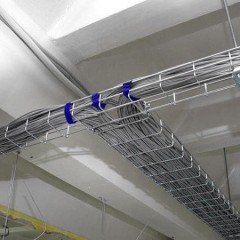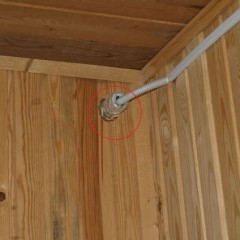How to lay the cable in the basement without breaking the rules
Installation advantage
The option of placing electrical communications in the basement of the building has a number of positive aspects:
- The remoteness of the main part of the wiring from the residential areas of the house reduces the risk of electric shock.
- Installing the wiring and cable in the basement is much easier, since there is no need to make the wiring hidden.
- In the event that the cable is damaged, repairs are not carried out in the living area.
Features of laying the cable in the basement we will reveal in this article. We also recommend that you read the instructions on how to how to make lighting in the basement with your own hands!
Work Stages
Installation of a guard
Having the bulk of the electrical communications in the basement of a private house, it is advisable to place a distribution panel in the same place, from which power is supplied to all consumer groups of the home network.
There are requirements that describe the current rules and regulations. They should be observed when choosing the installation location of switchboards, including when the basement or garage serves as such a place.
- The switchboard should be located in an accessible place convenient for repair and maintenance work, production of switching (in accordance with clause 7.1.28, Chapter 7.1 PUE).
- At the installation site of the switchboard, the level of illumination must be ensured, not less than 30 Lux, if incandescent lamps are used, and not less than 200 Lux when illuminated by fluorescent lamps. That is, the basement for these purposes should be illuminated additionally, in accordance with SP 31-110-2003 “Design and installation of electrical installations of residential and public buildings”.
- The base on which the shield is installed must be fireproof. The shield itself must also be made of non-combustible materials. Doors or covers of the electrical panel must be equipped with a lock and open outwards.
- The location of the electrical panel, wiring and the route along which the cable will be laid should not be subject to flooding.
- When installing the shield, a minimum distance of 500 mm from the piping of the water supply or heating system located in the basement should be ensured. The temperature in the room where the shield is installed must not be lower than + 5 ° C at any time of the year. The room must be provided with natural ventilation.
- It is not recommended to place shields under the toilet and bathrooms, showers and kitchens in order to eliminate the risk of flooding of electrical equipment. Avoid options in which the shields are located under the shutoff valves of water, heating or gas networks.
Electrical wiring
A cable or wire can be mounted in the basement in two ways: open or hidden wiring. The choice of concealed wiring method can only be dictated by aesthetic considerations; otherwise, an open gasket is preferable. If you rely on the rules of the PUE, according to paragraph 7.1.37, it is still better to implement open wiringas shown in the photo below:
Open wiring involves the use of corrugated pipes or cable ducts. If the basement has walls made of fireproof material, or there are fireproof structures on which the cable can be laid, the above cable accessories may not be used. Before wiring in the basement, it is advisable to draw a diagram on which to detail what, where and how to lay. Programs for making electrical circuits We examined in a separate article.
In basements with high humidity, where the cable is laid, PUE prohibits the use of corrugations and boxes made of metal (Table 2.1.2., Chapter 2.1) Moisture can accumulate in them, which increases the likelihood of breakdown of insulation on metal structures.
An open wiring is possible on combustible surfaces using a fireproof lining. For example, tapes made of asbestos fabric. Lining thickness cannot be less than 10 mm. If necessary, measures should be taken to protect the wiring from the temperature effects of heated pipelines.
Cable routing carried out in parallel to the passing pipe must provide a distance from the pipes to the cable of 100 mm or more. The gas pipes are even further from the electrical wiring - at least 400 mm. When crossing the wiring route with pipelines, a distance between them of at least 50 mm should be provided, the intersection with the gas pipeline should be at a distance of 100 mm or more. In cases where the distance between the pipes and the wire is less than 250 mm, the wires or cable must be protected from mechanical damage by a distance of 250 mm in each direction from the intersection. Learn more about how it can be done. protection of cable lines from mechanical damageYou can from our article.
Hidden wiring for fireproof constructions it can be carried out by an unprotected cable (wire) in isolation from fireproof materials, for example, VVGng-LS. If there are combustible materials in the structures, fireproof corrugations and boxes must be applied. If you intend to seal the wiring into the walls, it is recommended that you use only right angles when planning the route. This will protect in the future from accidental damage to the cable or wire when drilling the wall.
Finally, we recommend watching a video that clearly shows how the wiring can be done in the cellar:
That's all I wanted to tell you about how the cable should be laid in the basement of a residential building. We hope that the provided standards and requirements, as well as the methods of electrical installation, were useful to you and helped to independently carry out all the work. The last thing we want to draw your attention to is that the laying of transit cable lines in the basement is prohibited by the PUE (paragraph 7.1.42), so consider this point!
It will be useful to read:










